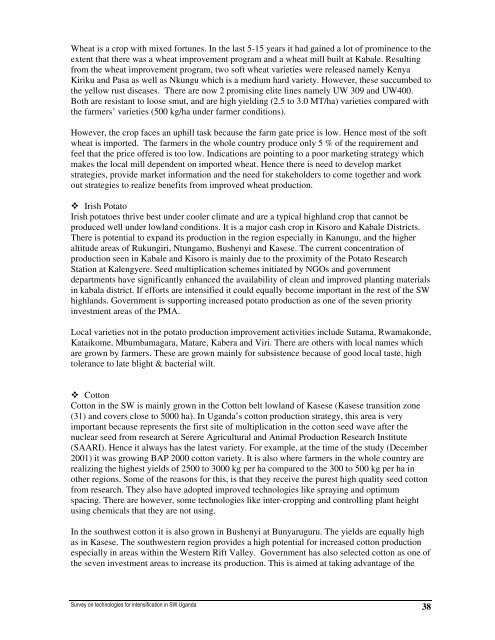Technologies for intensification in SW Uganda ... - Foodnet - cgiar
Technologies for intensification in SW Uganda ... - Foodnet - cgiar
Technologies for intensification in SW Uganda ... - Foodnet - cgiar
Create successful ePaper yourself
Turn your PDF publications into a flip-book with our unique Google optimized e-Paper software.
Wheat is a crop with mixed <strong>for</strong>tunes. In the last 5-15 years it had ga<strong>in</strong>ed a lot of prom<strong>in</strong>ence to the<br />
extent that there was a wheat improvement program and a wheat mill built at Kabale. Result<strong>in</strong>g<br />
from the wheat improvement program, two soft wheat varieties were released namely Kenya<br />
Kiriku and Pasa as well as Nkungu which is a medium hard variety. However, these succumbed to<br />
the yellow rust diseases. There are now 2 promis<strong>in</strong>g elite l<strong>in</strong>es namely UW 309 and UW400.<br />
Both are resistant to loose smut, and are high yield<strong>in</strong>g (2.5 to 3.0 MT/ha) varieties compared with<br />
the farmers’ varieties (500 kg/ha under farmer conditions).<br />
However, the crop faces an uphill task because the farm gate price is low. Hence most of the soft<br />
wheat is imported. The farmers <strong>in</strong> the whole country produce only 5 % of the requirement and<br />
feel that the price offered is too low. Indications are po<strong>in</strong>t<strong>in</strong>g to a poor market<strong>in</strong>g strategy which<br />
makes the local mill dependent on imported wheat. Hence there is need to develop market<br />
strategies, provide market <strong>in</strong><strong>for</strong>mation and the need <strong>for</strong> stakeholders to come together and work<br />
out strategies to realize benefits from improved wheat production.<br />
Irish Potato<br />
Irish potatoes thrive best under cooler climate and are a typical highland crop that cannot be<br />
produced well under lowland conditions. It is a major cash crop <strong>in</strong> Kisoro and Kabale Districts.<br />
There is potential to expand its production <strong>in</strong> the region especially <strong>in</strong> Kanungu, and the higher<br />
altitude areas of Rukungiri, Ntungamo, Bushenyi and Kasese. The current concentration of<br />
production seen <strong>in</strong> Kabale and Kisoro is ma<strong>in</strong>ly due to the proximity of the Potato Research<br />
Station at Kalengyere. Seed multiplication schemes <strong>in</strong>itiated by NGOs and government<br />
departments have significantly enhanced the availability of clean and improved plant<strong>in</strong>g materials<br />
<strong>in</strong> kabala district. If ef<strong>for</strong>ts are <strong>in</strong>tensified it could equally become important <strong>in</strong> the rest of the <strong>SW</strong><br />
highlands. Government is support<strong>in</strong>g <strong>in</strong>creased potato production as one of the seven priority<br />
<strong>in</strong>vestment areas of the PMA.<br />
Local varieties not <strong>in</strong> the potato production improvement activities <strong>in</strong>clude Sutama, Rwamakonde,<br />
Kataikome, Mbumbamagara, Matare, Kabera and Viri. There are others with local names which<br />
are grown by farmers. These are grown ma<strong>in</strong>ly <strong>for</strong> subsistence because of good local taste, high<br />
tolerance to late blight & bacterial wilt.<br />
Cotton<br />
Cotton <strong>in</strong> the <strong>SW</strong> is ma<strong>in</strong>ly grown <strong>in</strong> the Cotton belt lowland of Kasese (Kasese transition zone<br />
(31) and covers close to 5000 ha). In <strong>Uganda</strong>’s cotton production strategy, this area is very<br />
important because represents the first site of multiplication <strong>in</strong> the cotton seed wave after the<br />
nuclear seed from research at Serere Agricultural and Animal Production Research Institute<br />
(SAARI). Hence it always has the latest variety. For example, at the time of the study (December<br />
2001) it was grow<strong>in</strong>g BAP 2000 cotton variety. It is also where farmers <strong>in</strong> the whole country are<br />
realiz<strong>in</strong>g the highest yields of 2500 to 3000 kg per ha compared to the 300 to 500 kg per ha <strong>in</strong><br />
other regions. Some of the reasons <strong>for</strong> this, is that they receive the purest high quality seed cotton<br />
from research. They also have adopted improved technologies like spray<strong>in</strong>g and optimum<br />
spac<strong>in</strong>g. There are however, some technologies like <strong>in</strong>ter-cropp<strong>in</strong>g and controll<strong>in</strong>g plant height<br />
us<strong>in</strong>g chemicals that they are not us<strong>in</strong>g.<br />
In the southwest cotton it is also grown <strong>in</strong> Bushenyi at Bunyaruguru. The yields are equally high<br />
as <strong>in</strong> Kasese. The southwestern region provides a high potential <strong>for</strong> <strong>in</strong>creased cotton production<br />
especially <strong>in</strong> areas with<strong>in</strong> the Western Rift Valley. Government has also selected cotton as one of<br />
the seven <strong>in</strong>vestment areas to <strong>in</strong>crease its production. This is aimed at tak<strong>in</strong>g advantage of the<br />
38
















